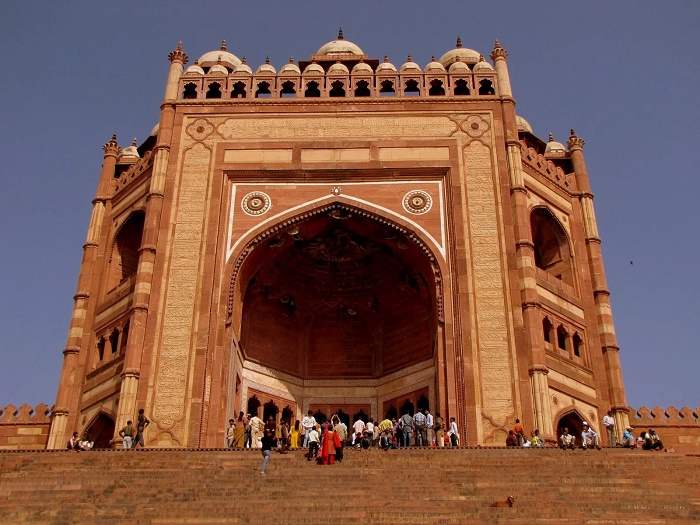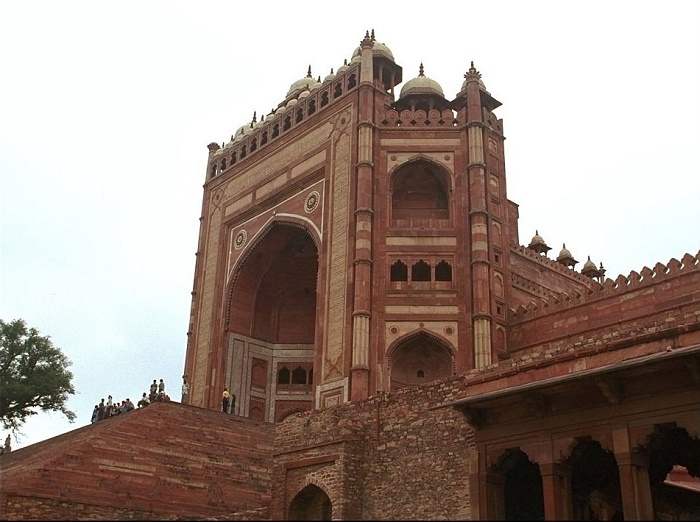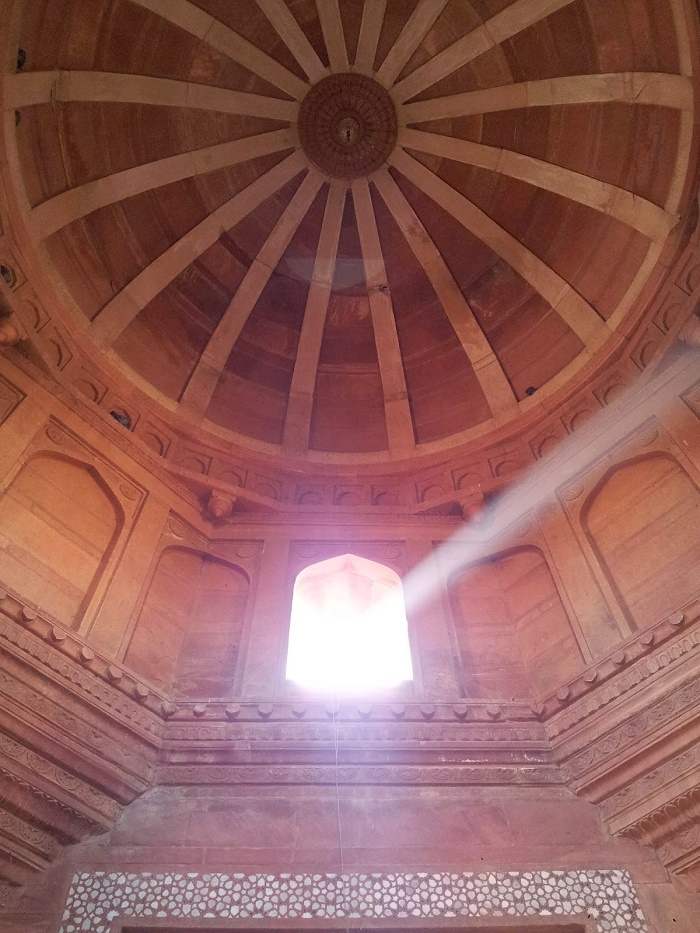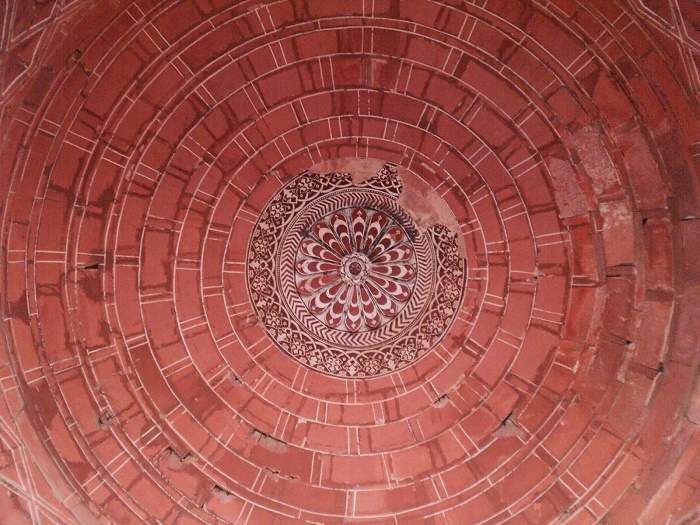When was it Built: 1601
Who built it: Mughal Emperor Akbar
Time taken: 12 Years
Where is it located: Fatehpur Sikri, Agra District, Uttar Pradesh, India
Why was it built: As a victory archway
Architectural Style: Mix of Hindu and Persian styles of architecture
Visit Timing: Daily, morning to evening
How to Reach: Nearest railhead is Fatehpur Sikri railway station (around 1 km) and nearest airport is Agra Airport (40 km). One can also avail UPSRTC or private bus services and cabs from Agra and neighboring regions to reach this place.

Buland Darwaza or the loft gateway at Fatehpur Sikri was built by the great Mughal emperor, Akbar in 1601. Akbar built the Buland Darwaza to commemorate his victory over Gujarat. The Buland Darwaza, approached by 42 steps and 53.63m high and 35 meters wide, is the highest gateway in the world and an astounding example of the Mughal architecture. It is made of red and buff sandstone, and decorated by carving and inlaying of white and black marble. An inscription on the central face of the Buland Darwaza throws light on Akbar's religious tolerance and broad mindedness.
The Buland Darwaza towers above the courtyard of the mosque. It is semi octagonal in plan and is topped by pillars and chhatris, echoing early Mughal design with simple ornamentation, carved verses from the Koran and towering arches. There are thirteen smaller domed kiosks on the roof, stylized battlement and small turrets and inlay work of white and black marble. On the outside a long flight of steps sweeps down the hill giving the gateway additional height. A Persian inscription on eastern arch way of the Buland Darwaza records Akbar's conquest over Deccan in 1601 A.D.

History, Architecture & Plan
This colossal monument that forms the main entrance of the palace at Fatehpur Sikri stands as a fine example of the architectural brilliance of the Mughal Empire that showcases an excellent mix of Hindu and Persian styles of architecture. Also called the ‘Gate of Magnificence’, it was added years later to the compound of Jama Masjid as a victory arch by the Mughal Emperor, Akbar the Great in 1601 A.D. to commemorate his successful Gujarat campaign of 1573. It took around twelve years to construct this architectural wonder.
This symmetrical entrance gate with chhatris or large kiosks atop is quite high than the courtyard of the mosque and is built with red and buff sandstones and embellished with black and white marble. There are gallery kiosks bordering the top centre of the roof which has small minar spires and carved indentations and is inlaid with black and white marble. The semi octagonal gateway is 15-storied high and has two three-storied wings on its two sides. Height of the mammoth structure is around 54 meters from the pavement and can be approached by climbing 42 steps from ground level. The top centre of the structure has three kiosks behind thirteen small domed kiosks. The gateway is surrounded by small turrets.

The main arch of the gateway with a dome atop lies in the middle of three projecting sides and is divided into three tiers having small arches in rows as also flat brackets. The two triangular surfaces, one of the three sides of each of which are bounded by the outer curves of the arch, are in plain red sandstone bordered with white marble and decorated with a flower like design made of white marble. The tip of the arch is also embellished with white marble sculpted like flower. The central arch again has three small arched openings that are outlined with ornamented panels and crowned by a semi-dome.
The huge pillars of the structure are embellished with fine carvings apart from inscriptions comprising of quotes from the Holy Quran and the walls are adorned with intricate designs. The towering arches, the verses from the Holy Quran etched on it and the simple yet elegant decoration of the gateway speak volumes on early designs of the Mughal era. It also comprises of three horizontal panels that are also found in the Badshahi Darwaza or the royal entrance that was built as an eastern gateway leading to the Jama Masjid at Fatehpur Sikri. Among the several colossal and significant structures of Fatehpur Sikri, Buland Darwaza remains the most towering one marking it as the highest gateway in the world.

Inscriptions on Buland Darwaza
The eastern archway of this royal gateway bears a Persian inscription that speaks of the victory of the great Mughal Emperor Akbar over Uttar Pradesh and Gujarat. His religious tolerance is manifested from another inscription that is etched on the gateway’s central face. It is an Islamic inscription etched in Persian language that elucidates the advice of Jesus Christ to his followers. Another inscription comprising of verses of the Holy Quran is also found in the gateway that was drawn by Khwaja Hussain Chishti, a disciple of the Sufi saint of the Chishti Order, Sheikh Salim Chishti. It is carved in Naskh, a distinct calligraphic style to write in the Arabic alphabet.

Image Credit: http://djjondent.blogspot.in/2015/03/fatehpur-sikri-india.html
A Visit to the Buland Darwaza
Located at Fatehpur Sikri, one of the most popular tourist destinations near Agra, Buland Darwaza stands as a testimony to the architectural excellence of the Mughals. As summers are scorching hot, the best time to visit this historic city is during the winters from around November to March. The mammoth structure situated right at the entry point of Fatehpur Sikri can be visited daily from morning to evening.



